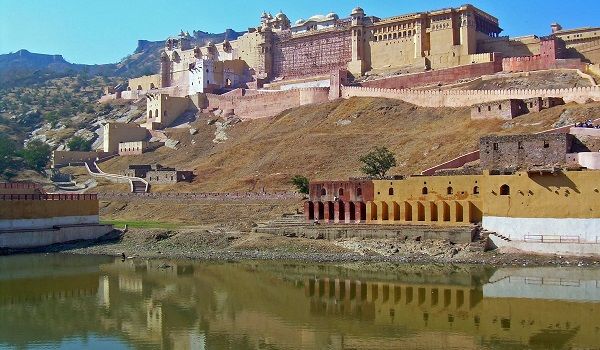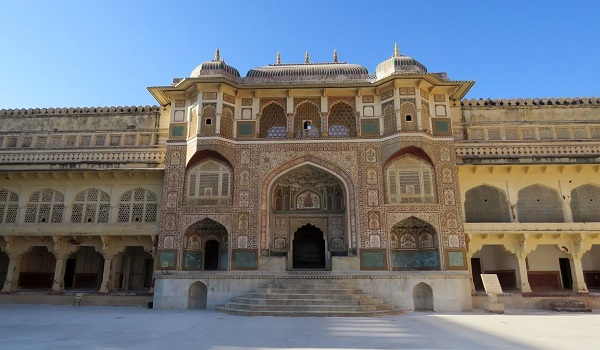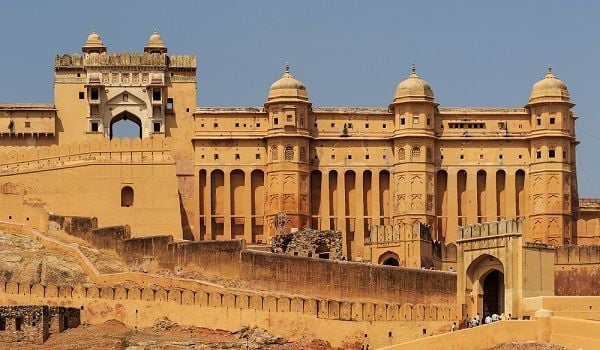Fast Facts
Location: Jaipur, Rajasthan
Built By: Raja Man Singh
Built in the Year: 1592
Materials Used: Red sandstone and marble
Purpose: Main residence of the Rajput Maharajas
Current Status: Amber fort was declared as UNESCO World Heritage Site
Visit Timing: 8am - 5: 30pm
Also referred to as the Amber Palace, the fort is located on a hill in Amer, Rajasthan. Just eleven kilometers from the city of Jaipur, the Amber fort is a major tourist attraction. Built by Raja Man Singh, the fort, which is also spelt as Amer fort, is a scenic marvel. It stands on top of an easily scalable mountain, which is situated right next to the beautiful Maota Lake. The fort’s majestic appearance and its geographical advantages make it a special place to visit. The fort presents a fascinating blend of Hindu and Muslim architecture. It is built using red sandstone and white marble. The palace complex of the Amber fort has very attractive apartments. This complex was built by Raja Man Singh, Mirza Raja Jai Singh and Sawai Jai Singh over a period of about two centuries. This palace complex was used as the main residence of the Rajput Maharajas for a long period of time. Amber fort is associated with rich history which involves treachery and bloodshed.

History of the Amber Fort
Raja Alan Singh, who once ruled the Chanda clan of the Meenas, was probably the first king to ever set foot on Amer. He set up his palace on top of the hill, which currently holds the Amber fort, and started to rule over his subjects in the new town. He named his town Khogong. One day, an old woman with a child approached Raja Alan Singh, seeking refuge in his kingdom. The king took them in openheartedly, and even raised the child who was named Dhola Rae. Dhola Rae was then sent to Delhi to spread the legacy of the Meena kingdom. Instead of obeying his king’s orders, he came back with a small army of his own, which comprised of Rajputs. The Rajputs then slayed everyone belonging to the clad of Meenas, without showing them any sign of mercy. It is said that the massacre took place on the day of Diwali, when the Meenas were conducting a special ritual known as ‘Pitra Trapan.’ Back then, it was customary for the Meenas to set aside all their weapons while performing ‘Pitra Trapan.’ The Rajputs, who were aware of this practice, took advantage of the situation and made Khogong their own. This act of theirs was considered as coward and despicable. The town along with the beautiful hill which held the palace like fort now belonged to the Kachwaha Rajputs.
Raja Man Singh of the Kachwaha house took over the throne from his predecessor in the early 1600s. He then started building the Amber fort after destroying the structure that was already built on top of the hill. The fort was further developed by the successor of Raja Man Singh, Jai Singh I. Over the next two centuries or so, the fort underwent continuous renovations and improvements under the reign of various Rajput Maharajas including Mirza Raja Jai Singh I. The present fort was completed in the late 16th century. In 1727, the Maharajas of Rajput decided to shift their capital from Amer to Jaipur, leaving no further changes to the appearance of the fort.

Construction
The construction of Amber Fort was started in 1592. It was modified on regular intervals by several rulers and the trend continued up until late 1600. The fort was mostly constructed using red sandstone and white marble. Though basically a fort, it also served as the main residence of the Rajput Maharajas. Hence, in its subsequent modifications, the fort was deliberately made to look more like a lavish palace. There is also another palace, which was constructed before the construction of Amber fort. The older palace rests on a valley behind the fort. This palace is one of the oldest in India.
Layout of the Fort
Four different sections combine to form the fort or the palace. Each section has its own gate and courtyard. The first gate, which is also the main entrance, is called Suraj Pol or Sun Gate. The gate faces east, witnessing the sunrise every morning and hence the name. This gate leads to the first courtyard named Jalebi Chowk. When the place was still being ruled by the Rajputs, the soldiers used to assemble and celebrate their victory in this very courtyard. This was a visual treat and was often viewed by women through windows. Since the royal dignitaries used to enter through the Sun Gate, the place was heavily guarded. The front courtyard of the fort complex is adorned with the splendid, pillared hall of the Diwan-i-Am, and the two-tiered painted gateway, Ganesh Pol. The entrance of the Amber fort is through the Dil-e-Aaram Garden, which is laid out in the traditional Mughal style. An impressive flight of stairs leads to the Diwan-e-Am (hall of public audience) which has latticed galleries and double row of columns, each having a capital in the shape of elephants on the top. This hall is laid on the second courtyard. To the right are steps that lead to a small temple of Goddess Sila Devi. The temple has massive doors made of silver.
There are two magnificent buildings laid out in the third courtyard. The buildings are situated opposite to each other. On the left, the beautiful Jai Mandir, which is also called Sheesh Mahal (palace of mirrors) is situated. As the name suggests, Jai Mandir was used to celebrate victories. Other celebrations too, were held in this building. The building opposite to Jai Mandir is called Sukh Mahal (Hall of Pleasure). This place was used by the royal family whenever they felt like they had to rest or spend some quality time alone. Towards the southern region of this courtyard, lies the famous palace built by Raja Man Singh I. This is the oldest structure in the entire fort as it stands today. The exit route from this palace leads directly to the town of Amer. The fourth courtyard is rather an interesting one. The royal women including the mistresses lived in this part of the palace. They were collectively known as the Zenana. Even the queens and queen mother lived in this part. This part of the palace was extremely secluded as the kings used to visit the queens or their mistresses without getting noticed by anyone.

Architecture
The architectural style of the fort is a blend of Mughal and Rajput architecture. One of the best examples of this style within the fort is the Ganesh Pol. Mirza Raja Jai Singh, who ruled the place from 1621 to 1627, was instrumental in building the Ganesh Pol. The gate is embellished with mosaics, which makes it look colorful and grand. Among the main attractions of the fort are Jai Mandir and Sheesh Mahal. While the Sheesh Mahal has walls inlaid with exquisite mirrors, the Jai Mandir, hanging on the upper floor, is a superb blend of Mughal and Rajput style of architecture. This is evident from the elegantly carved Jali screens and stucco work. Jal Mandir has a huge opening which is covered with sandalwood doors. A special feature of this structure is the flow of water through the building, making the entire hall air-conditioned. Sheesh Mahal too, has a special feature. Back then, the entire edifice would glow even at the light of a few candles, such was the architectural brilliance of this specially designed structure. The mirrors used in this palace are convex in nature. It was built during the reign of King Man Singh in the late 1600s.
Other major architectural attractions of the fort include the magic flower, palace of Man Singh and the garden. While the magic flower depicts two hovering butterflies, the palace is known for its pavilion. The garden resembles the Chahar Bagh or the famous Mughal Garden. Also, there is a pool which is star-shaped at the center of the garden. Another interesting architectural design of the fort is the fourth courtyard. Since the kings had to visit their queens and mistresses in secret, the courtyard demanded a special design. It was built in such a way that no one could guess which room the king would enter as the courtyard, with multiple rooms, had a common corridor. The walls of Amber fort are adorned with paintings of hunting and war along with precious stones and mirrors set into the plaster. The Maota Lake at the forefront of the fort gives spectacular and beautiful reflections of the magnificent Amber Fort-Palace.
Conservation of the Fort
The fort, along with five other forts of Rajasthan, was named as one of the UNESCO World Heritage Sites in the year 2013. The ADMA (Amer Development and Management Authority) has so far spent around 40 crore rupees to safeguard the fort from threats and external damages. However, commercialization of the fort is proving to be a huge threat. It is said that a team of a Bollywood movie damaged an old canopy belonging to the fort. The team had also damaged edifices like Chand Mahal, a courtyard named Jaleb Chowk and other ancient buildings by drilling holes as part of fixing a set for the movie. The Rajasthan High Court had condemned this act and stopped any further damage by cancelling permission to shoot the movie within the premises of the fort. Following this incident, no movie is allowed to be shot anywhere near the Amber fort.



